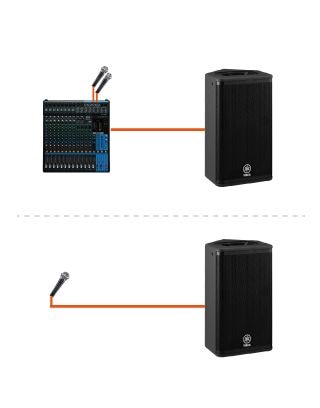What are speakers?
Speakers are devices that convert electrical signals amplified by the amplifier, into vibrations of air that can be heard by humans as sound. Speakers come in various shapes and sizes, types and models.
Speaker types, based on amplification method

There are two main types of speaker, based on where the signal is amplified. The characteristics of each type is described below.
(1) Passive speakers
Speakers that only feature basic speaker functionality can be called "passive" speakers. These speakers require a separate power amplifier in order to produce sound.

(2) Powered speakers
Speakers that contain an internal power amplifier can also be called "active speakers". Since these speakers contain a built-in power amplifier, they can be directly connected to a mixer, which reduces the number of cables required. (Though of course an electricity power cable needs to be connected to each powered speaker).
Models such as the Yamaha DXR series or the DBR series allow for microphones to be directly connected and provide basic mixer functions built into the speaker.
Tips
To build a PA system easily and as simply as possible, it is better to use powered speakers, which require fewer connections. However, passive speakers offer a comparatively high level of freedom, in situations where the speakers may be moved around, changed or added to.
Speaker types, by use
Various types of speaker are used in PA systems, each with a different purpose.

(1) Main speakers
These are the speakers that deliver most of the sound to the audience or listeners. Decide on the size and number of speakers according to the size of the venue, as well as by the amplifier output power (in the case of passive speakers).

(2) Subwoofers
These speakers are designed specifically for low frequency sound playback, and are used together with the main speakers to boost the low-end sound range.

(3) Monitor speakers
These speakers are used by the performers to monitor the sound. Monitor speakers are positioned in various ways depending on their shape, such as on the floor or on a stand.
When choosing a passive speaker, it is a good idea to check the speaker size, impedance, power rating, and sound pressure level (SPL) by referring to a catalog or other source of information.
First of all, look for the speaker size in the component's LF item ("Components" or "Speaker Unit"). In general, for the same series of speakers, the larger the speaker radius, the easier it is to produce sound in the lower frequency range.

It is important to consider speaker impedance. In the chart below, the impedance for all speakers is 8Ω (ohms). See the following section, "Adding speakers and calculating impedance" for more details.

Next, check the maximum input (power rating). The power rating shows how many watts can be input to the speaker. There are multiple items in the specifications for power rating, depending on the method of measurement. In general, refer to the PGM (also shown as "Music" in some cases).

Lastly, study the sound pressure level (SPL) that can be output. As with the power rating, there are multiple items in the specifications for the output SPL, depending on the method of measurement. The peak (max) value is the maximum output level for that speaker.

Once the speakers have been selected, choose a power amplifier that matches the specs of the speakers.
<Note> When choosing a powered speaker, it's a good idea to refer to the power amplifier output, as well as the "Components" or "Speaker Unit" inside.

The power amplifier output will change, depending on the impedance of the speakers connected. For example, when connecting a pair of 8-ohm speakers and a pair of 4-ohm speakers to a Yamaha PX3 power amplifier in stereo, the output is as shown below.
Although the amplifier is exactly the same, when two 8-ohm speakers are connected in stereo, the output will be 300W+300W. For 4-ohm speakers, the output will be 500W+500W.

However, if speakers are added by connecting them in parallel, the total impedance for the speakers will change, resulting in a different power output. Impedance is a compound resistance value: the greater the resistance, the harder it is for electricity to flow; and the less the resistance, the more electricity flows. The lower the impedance (ohms) (which is the resistance mentioned here), the greater the number of watts output by the power amplifier.
When two 8-ohm speakers are connected in parallel, the total impedance for the two speakers is 4 ohms. The PX3 power amplifier can be used at 4 ohms, and the output power will increase with reduced impedance.
The benefits to connecting speakers in parallel are an increase in output compared to just using one speaker per stereo side, as well as the ability to angle the speakers to cover a wide area with sound. Speakers are often added at the live venue in order to enhance the audio system.

With only one speaker per side

With two speakers per side
Caution
Although there are benefits to adding speakers, pay attention to the total impedance when connecting speakers in parallel.
For instance, when two 4-ohm speakers are connected in parallel, the total impedance for the two speakers is 2 ohms. You'll need to pay attention when driving speakers at low impedance, as this puts a greater load on the power amplifier.

How to calculate the total impedance for parallel connections
R1 (impedance of speaker #1) = 4 ohms
R2 (impedance of speaker #2) = 4 ohms
R (impedance total) = 2 ohms
Understanding the relationship between amplifier output, speaker and impedance is crucial in building an effective and safe PA system.
Tips
In the case of passive speakers, which can be connected in parallel (example: the Yamaha CBR12 passive speaker), the system is designed so that the signal from the power amplifier is received by one of the two input connectors (phone connector or SpeakON connector) using a dedicated speaker cable, and the other connector is used to send the signal to speaker #2 using another dedicated speaker cable.
Adding powered speakers

When adding passive speakers, attention needs to be paid to the speakers' impedance.
However, powered speakers are much easier to add.
With Yamaha's DZR, DXR and DBR series powered speakers, the connectors labeled OUTPUT/THRU/LINK OUT can be used to add other powered speakers. Keep in mind that adding DZR, DXR, or DBR series speakers requires a cable with XLR connectors.






